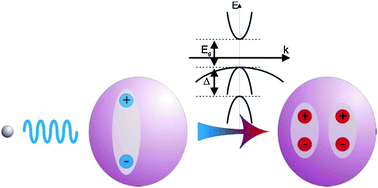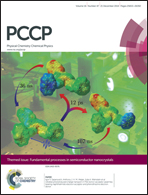Multiple exciton generation in cluster-free alloy CdxHg1−xTe colloidal quantum dots synthesized in water†
Abstract
A number of different composition CdxHg1−xTe alloy quantum dots have been synthesized using a modified aqueous synthesis and ion exchange method. The benefits of good stoichiometric control and high emission quantum yield were retained whilst also ensuring that the tendency to form gel-like clusters and adsorb excess cations in the stabilizing ligand shells was mitigated using a sequestering method to remove excess ionic material during and after the synthesis. This was highly desirable for ultrafast carrier dynamics measurements, avoiding strong photocharging effects which may mask fundamental carrier signals. Transient grating measurements revealed a composition dependent carrier multiplication process which competes with phonon mediated carrier cooling to deplete the initial hot carrier population. The interplay between these two mechanisms is strongly dependent on the electron effective mass which in these alloys has a marked composition dependence and may be considerably lower than the hole effective mass. For a composition x = 0.52 we measured a maximum carrier multiplication quantum yield of 199 ± 19% with pump photon energy 3 times the bandgap energy, Eg, whilst the threshold energy is calculated to be just 2.15Eg. There is some evidence to suggest an impact ionization process analogous to the inverse Auger S mechanism seen in bulk CdxHg1−xTe.

- This article is part of the themed collection: Fundamental Processes in Semiconductor Nanocrystals

 Please wait while we load your content...
Please wait while we load your content...